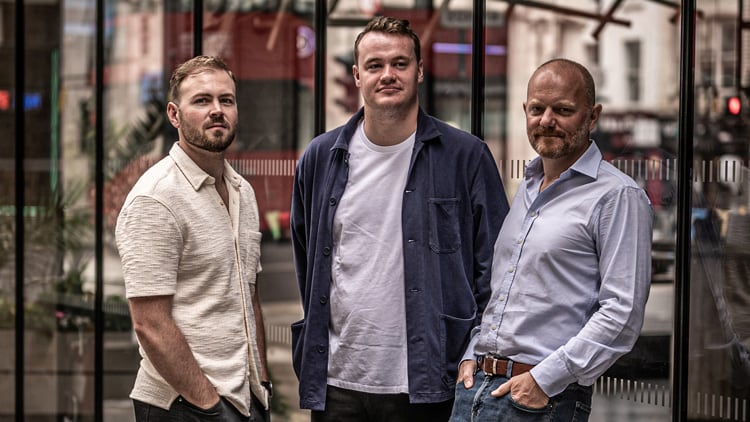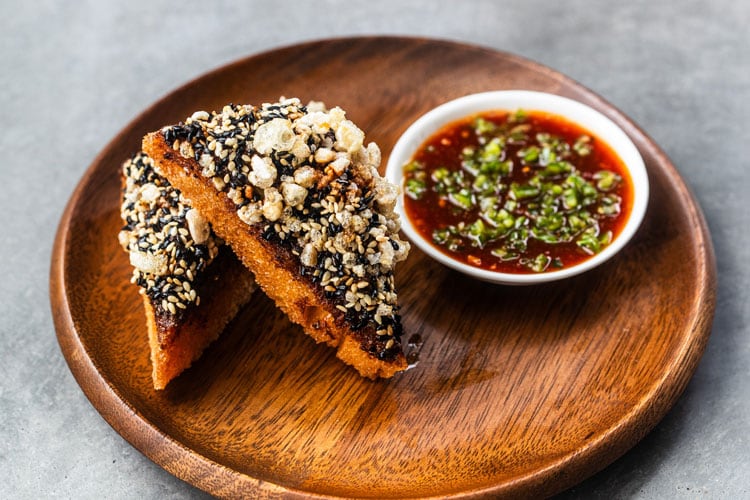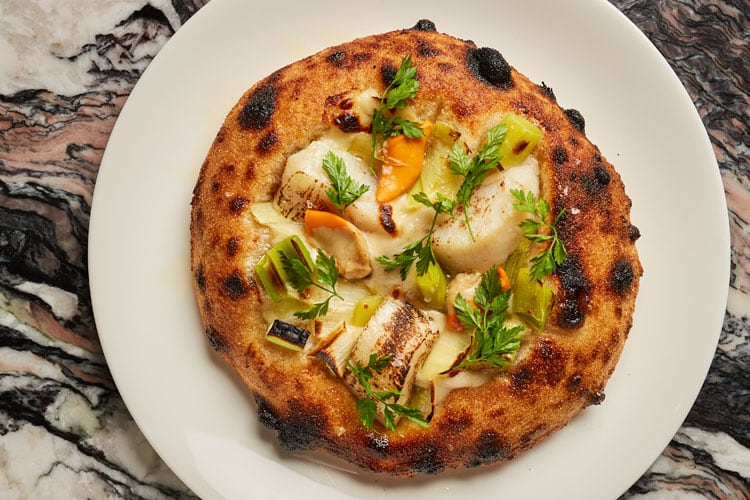There are times when an idiom encapsulates perfectly the mood of a situation, and in the case of Fallow founders James Robson, Will Murray, and Jack Croft it’s ‘go big or go home’. Located on the ground floor of a towering circular waterside apartment building in Canary Wharf’s Wood Wharf their new restaurant Roe is a distance - both metaphorically and physically - from Fallow, their St James’ Market restaurant, and FOWL, their more recently launched chicken shop located just round the corner from it.
The exact number of covers Roe can handle is moot - anything from 250 to 500 in one sitting depending on variables such as the weather and how the kitchen is running - but the expectation among the trio is that it could easily do 1,000 covers a day. In reality, even that figure could woefully underestimate the restaurant’s full potential when it is operating at full tilt.
“We are going to cap covers at 100 a service to begin with but it could do tenfold,” says Robson of his new baby, which officially opens today (22 April). “Every table that I thought might sit six people can fit seven or eight; every table of eight can fit 10, and the covers have just ended up slightly more than we envisaged.
“If we’d have had this conversation at Fallow two years ago and said we were going to do 750 covers in February we’d have said ‘no way’. But we are doubling the size of Fallow with the terrace this summer, so 1,000 covers a day is coming, which is nuts. Simply put, this place [Roe] is twice the size.”

A space oddity
To understand Roe fully you need first look at the smash hit that is Fallow, the debut restaurant from serial restaurateur Robson and former Dinner by Heston Blumenthal chefs Murray and Croft that put down permanent roots in late 2021.
When Fallow opened in St James’s Market (the entrance is actually on Haymarket) it was the fourth iteration of a restaurant that had run pop-ups at London venues Carousel and Crispin before a longer stint on Mayfair’s Heddon Street paved the way for permanent digs. Located in what was then deemed to be a tricky site that was the former home to the short-lived Duck and Waffle Local, Fallow became an instant smash with its ‘conscious gastronomy’ serving high-impact sustainable dishes wowing critics and the industry alike and, more importantly, bringing in the customers in their droves.
So many people have since walked through Fallow’s doors and ordered its now legendary smoked cod’s head dish doused in home-made sriracha that less than three years on the trio have dared to dream with a project that eclipses pretty much every new restaurant openings in London this year in terms of scale.
“We have come to understand that conflict
is basically creativity, it gets good results”
Despite their early success, a follow up project of such size wasn’t initially on the cards, but it inevitably played its part in the decision-making process. Sites they considered included in locations such as Spitalfields and 40-50 cover venues in Soho that, according to Croft, were “more suitable sites for our expansion needs”.
“There was a big debate whether we just open another Fallow in east London,” adds Murray. “It would be easier to do that, but we felt that it was a really special concept and wanted to keep it unique.”
Canary Wharf - and specifically Wood Wharf, which is home to relative newcomers Dishoom and Hawksmoor - eventually became the curve ball that was too enticing to ignore.
“It’s a site that was turned down by a few people,” says Robson. “It’s a very weird building, which makes it challenging.” In every other plan for the building Robson says the kitchen was where the PDR is located, close to the entrance, with a massive dining room. Instead, the trio settled on running a line kitchen and bar across one side of the entire room to break up the space.
“Roe has got to be front focused because, like Fallow, we will rely on that chef energy,” he continues. “I was worried about the space the kitchen takes up as you walk through the room because of the pinch points it might create, but in initial tests it does work.”
“The pros [of the site] far outweigh the cons,” adds Croft. “It is big but the fact that the landlord was willing to work with us gave us the opportunity to become more sustainable and have things like an aeroponic wall, which means that it will be more sustainable in the long run than what we can do at Fallow.”
Said aeroponic wall is a living wall of plants and vegetables such as peas, a variety of different peppers, strawberries, and herbs (lemon verbena, butterfly sorrel) that will be used across the menu. The wall represents a significant investment for the business as it looks to further bolster its sustainable credentials.
In a similar vein, the dining room features a large central structure that features a texture derived from the growth pattern of corals. Made from plant-based and compostable 3D printed material, it is also an integral feature of the restaurant’s snaking 40-foot marbled topped counter that divides the open kitchen from the dining room. Should any panels get damaged they can simply be removed, melted down and reprinted before being returned to their position without the need for any new material, Robson proudly points out.

Three’s a crowd
Such aspects are not the only things that makes Roe unique. The company ownership of two head chefs alongside a restaurateur also means that Fallow, and subsequently Roe, operates in a slightly different way to many other restaurants.
“Another reason I wanted to expand is that there are three owners and three in one room was never going to work long term, it’s too compact,” says Robson. “Two sites for three owners is much more convivial.”
The dynamic of the trio is an interesting one. Together they put on a united front, but they are evidently very different characters at heart, something to which they admit freely.
Croft is described by the others as being ‘systems focused’ with an intense eye for detail and a love of processes whereas Murray is considered to be a hyper creative type. Robson, as the only non-chef of the trio but with a strong background in hospitality, having once established a portfolio of venues in London, including Mews of Mayfair, La Cave, Mayfair Pizza Co, and Cartizze, is more colloquially known for ‘getting shit done’, whether that be negotiating with councils on outside space, or playing peacemaker with the locals when stuff doesn’t go to plan - at Roe’s first trail run seven fire engines turned up meaning 150 people were unable to get into their penthouse flats above. Together they make a formidable threesome.
“We are all very headstrong, confident and good managers who work in very different ways,” says Croft. “Our relationship is the most rewarding, the most difficult, the most emotionally hard. The best thing we can do is focus on this relationship because everyone else thrives on that.”
Does headstrong mean that they argue? “We have learned tolerance and don’t always see eye to eye,” is Robson’s diplomatic response. “We are all fast moving, all passionate, and all care too much. Stick three people in the room like that all the time and they will eventually end up at each other’s throats. But we have learnt to forgive, move on, and not hold grudges.”
“We have come to understand that conflict is basically creativity, it gets good results,” Murray adds.
Having two chefs of equal standing, rather than the more traditional head chef/sous chef or executive chef/head chef dynamic is unconventional, but has its advantages. Murray and Croft develop every dish together (Robson jokes that he occasionally gives his input but is “told to fuck off”) although not necessarily in tandem. “We might not develop the dishes together, but we taste every dish together, in every restaurant,” says Croft. “That is the one thing we never want to lose. It takes twice as long but we get a better result at the end of it.”
“We are super critical about every element of every dish,” adds Murray. “These dishes have to be bullet proof to do 750 covers. We are not creating something really good for one day or one week’s service, it’s got to be repeated hundreds of times.”
Running the pass at Roe is yet another Dinner by Heston Blumenthal alumnus, head chef Jon Bowring.

A moveable menu
As to the menu itself, Roe continues Fallow’s and FOWL’s ‘nose-to-tail, ‘root-to-stem’ ethos that sees it champion underutilised animals and cuts as well as home-grown ingredients yet has a different focus to its sister restaurants.
No dishes from the Fallow menu are present; instead, Roe takes inspiration from Croft and Murray’s love of Turkish restaurants, in particular Lee Tiernan’s Black Axe Mangal, with skewers and flat breads a core part of the offer. The food style is what Murray describes as “food that chefs want to eat” with the trio keen to continue Fallow’s reputation as a place for the industry to eat on its day off as well as for regular customers.
Skewer options include smoked lemon chicken with hazelnut satay; and monkfish with lemon and chorizo, while flatbreads feature toppings such as snail vindaloo coated in a sauce made from smoky bacon, mustard seeds, cumin and coriander.
“These dishes have to be bullet proof to do 750 covers.
We are not creating something really good for one day -
it’s got to be repeated hundreds of times”
Other standout dishes are its blooming onion; a riff on prawn toast (pictured above) made with cuttlefish topped with puffed pork skin and served with a chilli dipping sauce made with chillies from the aeroponic wall; and a meat-free Cornish pasty made with maitake and oyster mushrooms served with a walnut ketchup.
“We don’t know what dishes will win here, it’s not just about the meat,” says Robson. “When you put cod’s head on the menu you can’t do anything else, whereas skewers can change seasonally or with what our suppliers have. It’s the same with flatbreads, they are so versatile. The possibilities are endless.”
As the name Roe suggests, venison will also feature heavily on the menu (Fallow, incidentally, was not named after the breed of deer but rather the farming cycle), which Murray describes as “a sustainable super food”. Despite its connotation with the higher-end restaurant sector, venison remains good value when compared to similar meats and is, according to Murray “the most sustainable meat you can eat in England”. “People think of it as a super-premium meat, which it is, but it is does not carry a hugely premium price, especially if you butcher it all down yourself.
Venison dishes will include the Roe mixed grill featuring harissa flamed haunch, skewers and sausages served with smoky peppers; venison charcuterie; while a Roe burger will also contain venison meat.
“The one thing we were worried about was having a certain identity and whether Roe was different enough to Fallow,” says Croft. “The feedback is that it is. The food is simpler, there are fewer elements on a plate, but it feels more refined.”
The trio believe there is also scope to make a play for Wood Wharf’s potentially lucrative breakfast market, following the success of Fallow’s early morning offer, but will focus on lunch and evening in the short term.

A digital future
Roe might be the group’s third restaurant, but the trio actually regard it as their fourth project, with the digital and social media side of things having become a core pillar of their approach.
The business operates four Instagram channels, one for each of its restaurants and another called Herd Chefs where Croft and Murray give recipes and cooking tips. It also has a presence on TikTok and YouTube with a monthly reach of 30 million views - Herd Chefs recently broke the one million follower mark.
Its success on social media is down to yet another unique approach that Murray refers to as "radical transparency". Its Fallow Instagram account lifts the lid on running a restaurant, tackling industry issues as wide reaching as rising food prices and GP, the Maillard reaction, fluid gels, emulsions, why the team doesn’t wear disposable plastic gloves, and extolling the virtues of wooden chopping boards.
“There are a lot of things in hospitality people are too afraid to say, we’ve said we will be transparent about everything we do.” says Murray. “It has really resonated with people.”
“Doing food videos is half of what TikTok and Instagram is,” adds Croft. “People are cooking in their houses or gardens, but the difference is that we do it from a professional angle in a restaurant kitchen. People love that inside detail, the way it looks, and how we operate.”
While the team can’t quantify the direct impact of social media on the business, they are convinced their restaurants are busy because of it. “Tourists book us when they book their flights, our international bookings come in so far in advance,” says Robson.
"The food is simpler [at Roe], there are fewer elements
on a plate, but it feels more refined”
More recently they have doubled down on their strategy. The business now employs a digital team of around nine full-time members of staff and says Herd Chefs might one day become the umbrella name for all of its social media output. The intention is to bring in more people from the business into is channels having seen the success of such an approach taken by the Youtuber collective Sidemen.
“Eventually we might just become a social media group with restaurants rather than a restaurant company that’s funding our digital - digital may fund the business,” says Croft. “The food will always come first. Our passion is owning and running restaurants, but this is a tool to help run those restaurants better.”
“We could morph into more of a digital company in the future or roll out big restaurants, or do something on a smaller scale,” adds Robson. “There is no strategy other than trying to make the most of the current situation.”

Organic growth
In the immediate future, the trio are keeping their attention on building on the work at Fallow and FOWL as well as getting Roe up and running. Robson plans to boost FOWL’s outside space and has bought 150 chairs for its terrace, extending significantly the 60-cover restaurant. Numerous partnerships are planned for the restaurant, including one with Professor Green and another with ‘bosh’ brayer ‘Big John’ Fisher.
“The Crown Estate is going to look at us and say ‘what are you doing?’. And then they are going to smile because we are going to create some energy in that square,” laughs Robson, who adds that he has also bought another 100 chairs to add to the 80 already outside Fallow.
“Fallow will go up 50% this year. It went up almost 50% last year now that we understand our terrace,” he says. “We’re doing breakfast, we’ve opened FOWL, and we are growing organically.
“It is far from finished. This will be the year that cements it.”


